Outsider article
In 2006 I wrote an article on our trip in Latin America for outsider.ie, Ireland’s outdoor magazine. The magazine and website are still on the go, but my article is no longer available there. Luckily I had a copy saved on a harddrive, so here it is, somewhat rebuilt.


Indecision - The Key to Flexibility
Submited by Jim Kennedy
15 November 2006
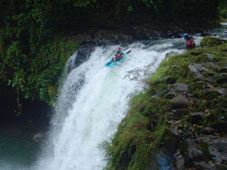
There is something obvious about picking a route to travel through Latin America – begin in the north and work your way down the Mexican coast, along the narrow strip of Central America, and slip down the coastal plain of South America between the ocean and the mountains - the Pacific on the right and the Andes on the left. Stop when there are oceans both to the right and to the left. With such landmarks guiding the way, it’s almost impossible to get lost.
Considering this unsophisticated thinking and the token amounts of conventional planning, our kayaking trip was astonishingly successful. Despite the presence of big 4x4 vehicles, extreme terrain, long durations, and the tough nature of most of the kayaking, this adventure was no expedition, just a trip. Expeditions are organised, highly resourced, logistically tight, and executed by goal-oriented teams, giving them certain legitimacy. Our trip wasn’t so much disorganised as unorganised, scantly resourced and with little thought given to logistics. Frankly we had no right to get anywhere. The original ‘mission statement’ mentions leaving Dublin in October 2004 and ‘hoping’ to make Chile the following March. Amazingly, this came to pass. Does this lend our trip an air of legitimacy? No, it was a bastard born of too many illegitimate pub conversations. Achieving this trip was largely down to a strict adherence to our long-established motto – ‘Indecision is the key to flexibility’ – newly and badly translated into Spanish. Our planning and execution remained highly flexible throughout.
Bad Beginning in the USA
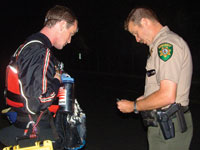
Our initial foray into paddling in the Americas ended up being one of the most disastrously mismanaged days of the trip. Certain people still don’t want to talk about it, but suffice to say it’s often best to get the disastrous stuff out of the way upfront. The day began well under beautiful Californian skies, and ended with the assistance of the local police and a dramatic night-time helicopter extraction from the river. Some stories are funny after the event; this was funny even as it happened.
Good Beginning in Mexico
Moving swiftly along, we got things back on the right track a few weeks later in Mexico’s Barranchas del Cobre (the Copper Canyon, the deepest canyon in the North Americas); hiking the boats down 1,600 metres on the backs of a couple of burros, camping over-night on a river beach, and kayaking through 46 km of the Rio Urique the following day. It had taken an entire day just to get from the rim of the canyon down to the river beach, so kayaking the next day at the base of the canyon, a six-hour descent from the rim, was a relief – that the day went well and relatively uneventfully, was beyond a relief. We took this day as our second first beginning, and the following six months took their cue from there.
Sometime the reasons for going kayaking are about the old mountaineering stories of ‘because it’s there’ or ‘valuing your life by risking it’ but sometimes it’s because of the people you meet. In Mexico, for example, we didn’t do any kayaking that could be said to stretch our abilities, but it was perhaps one of parts of our trip that we appreciated the most, just on the basis of the Mexican people we met, only some of them paddlers.
Rich Pickings in Costa Rica
On a kayaker’s mental map of the world, Costa Rica occupies the same part as the Alps does for mountaineers - it’s on the wish list for years, and once you finally get to go there, you know you’re ready. It’s exotic but achievable, far away but reachable. In terms of logistics, Costa Rica allows you to relax and focus on the paddling. You can run every kind of river here – rocky creeks, such as the Rio Orosi, big water play rivers, such as the world-renowned Rio Reventazon, read-and-run waterfalls, such as Poza Azul, and everything you could possibly want from one river in the Rio Pacuare. For us the highlight was the Rio Toro.
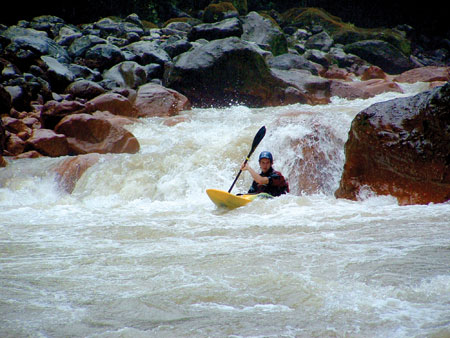
In Costa Rica, where so many rivers are rightly labeled ‘classics’ one of the most memorable of our month there remains the Rio Toro. Beginning at the head of a valley that looks like something from ‘The Lost World,’ the put-in is overlooked by vertiginous cliffs, a 200-metre waterfall, and a small power station somehow managing not to look incongruous. As the almost constant rain dumps water into the constricted valley, the vegetation takes on a vividly green and lush appearance and the rounded boulders have a slick rusty-red colouring. The Toro is a rock-strewn mountain river with a consistent gradient, where it seems as if it will never let up, continuously dropping away in front of the nose of your boat. Twisting ledges around corners, constant apprehension as you race into the next bend, all the time conscious of descending further and further away from the road. On the first boating day in Costa Rica on this river, we had cracked a hole in one boat while still within sight of the start, forcing us to signal frantically to our shuttle driver not to leave. On our last boating day in Costa Rica, faced with a choice of going back to attempt the Toro again or run La Paz waterfall, we felt that this classic had it all, so back we went. At the get-out there is a thermal springs where we sat awaiting our shuttle back to town relaxing in the warm water, as the rain continued to pelt down.
Days later it all began again, with the team flying to Ecuador, equaling in a few hours of flight the distance driven by car in the previous number of months.
Ecuador
In keeping with the friendly nature of international kayaking, we combined forces with a crew of Scottish boaters for a number of weeks. Ecuador was the most consistent section of our trip in terms of the style of boating - the river characteristics were consistent across the various centres out of which we based ourselves and many of the rivers seem to blur together in the recollection - all rocky, low water, technical and tight, hard on gear. In that sense, it was a lot like Ireland, but warmer. It was more exposed too, with the sense that if things were to go wrong, some of the routes to walk out of the jungle would take a number of days, not hours.
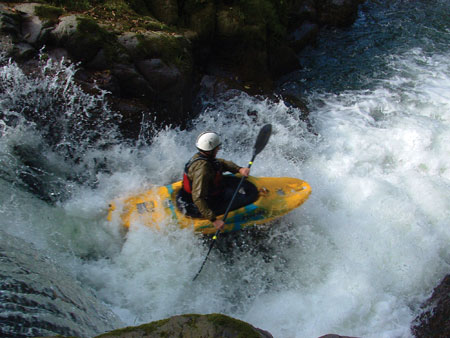
Patagonia
We had said goodbye to our 4x4 in Costa Rica, striking quite a decent deal for ourselves in the process (selling it for a few hundred dollars less than we paid for it and then bumming a lift to the airport from the new owner). Since then we had traveled the intervening distance from Ecuador to Chile on the public buses, just like the regular members of the public, and felt the need to take our enterprise into the private domain once more. Subsequently, the newly acquired little yellow school van carried us across the Andes from Chile to Argentina and back again several times, all in search of Patagonian kayaking. The kayaking here, albeit difficult to access in the remote regions of the southern Andes, is some of the finest in the world and certainly the hardest and most committing days of our trip were spend in this most beautiful parts of the Americas.
Camping by the banks of these hard, punishing rivers waiting for the day to begin, gives you plenty of time to take it all in. Sometimes you travel a long way to spend a short time on the water, and for a kayaker the time on the water is ultimately all that matters. Patagonia is different. The journey itself, and simply being there, in the valleys, can be enough.
Rio Manso
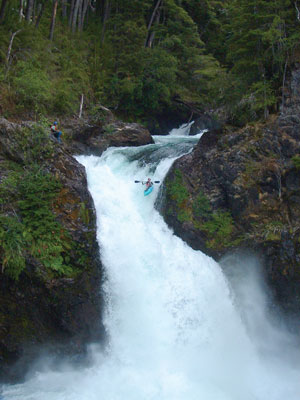
The sport of kayaking is a many-faceted thing; not all of them available in one place, so Latin America presented endless new experiences to us. In our trip we paddled steep creeks, big volume monsters, and remote canyons, but running huge waterfalls was entirely new. Several of the classic rivers of the Chilean and Argentinean Patagonia are punctuated with vertical walls of frothing water, of a kind that none of us had ever encountered before. The immediate and most obvious result of this was to return us to our beginnings as kayakers – the combination of terror and inexperience that leads to serious questioning about your ability to boat is something familiar to every novice kayaker.
So it was for us again, sitting in eddies mere metres from the lip of appalling messes of vertical water. In the old days, kayakers measured their readiness to run scary rivers using the ‘expectoration test’ – if you can’t summon up enough spittle to spit, then perhaps you’re not ready yet. La Cascada de Los Alerces on the Rio Manso came close to failing us on the ‘dry-mouth’ test. This wasn’t the biggest drop of the trip, but easily the longest time any of us have inspected a drop and still run it. With the experience of walking way from La Paz waterfall in Costa Rica still fresh in mind, there was a kind of grim determination to get to grips with this one.
Rarely run, this waterfall requires a technically precise entry move – running down the left-hand side of the river to avoid the turbulent trough of whitewater in the center, before ramping hard off the lip to throw the boat out beyond the crease, with the aim of reuniting with the falling curtain, all the while trying to torque around to face downstream for the plunge into the base of the drop. We had been running bigger and bigger waterfalls in the preceding months, but this was something new. In the end, as every beginner eventually learns, kayaking is all about the willingness to leave the safety of the eddy behind. It’s fairly lonely in the eddy above this drop. Nice, quiet, and you don’t really want to ferry out of there; as always the hardest paddle stroke is the one that puts you beyond the point of no return.
Rio Futaleufu
Like a canvas tent, the rain clouds seem to drape themselves across the ridgepole of the mountain range, insulating and muffling all the sound. It seems immensely still in places like the valley of the Rio Futaleufu, deceptively so when you are floating down into the first rapid of that enormous river. For our trip, the Rio Futaleufu was by far the biggest volume of water we had edged out into - think of the volume of the Shannon River constrained into the Glen of the Downs. As the course available to the water narrows, the river goes from being a quiet sweep of smooth water into a gauntlet of foam-topped waves and stoppers crashing above the kayak, and the noise rises with it.
For whitewater kayakers, the valley of the mighty Rio Futaleufu is one of the fabled destinations. This huge swathe of river drains enormous volumes of turquoise water from the Patagonian highlands and, at the same time, draws boaters from much further afield. And now it was our turn - a long-imagined arrival that, of course, was nothing like the expectation.
Below the Chilean town of Futaleufu, we put ourselves and our road-weary kayaks onto the waters of the calm eddy above La Entrada rapid. The water had travelled quietly in its channel from Argentina; us more noisily overland from sunny California. Below this eddy, the roles are reversed - the waters roar into the canyons and we are suitably silent.
Our first day there was also the single biggest water day of the entire year, with only us on the river, everyone else opting not to paddle this day, choosing to wait instead until the level dropped. All of this was news to us until we got off the river, eyes out on stalks, having escaped unscathed from huge crashing waves, big raft-eating holes, and a scary pour-over rapid known simply as ‘Pillow.’
For us, the Rio Futaleufu was the big turning point of our trip - this is as far south as we would paddle and after here we were to hang up our paddles and become backpackers for a while.
Before here, we had misplaced people in rain-swollen torrents in Costa Rica, been confined by the giant walls of Mexican canyons, abseiled around terminal river holes in the Ecuadorian jungle, and thrown ourselves off steep waterfalls in Argentina.
Off the river, we had travelled by foot, chicken bus, luxury bus, 4x4, plane, donkey, train, motorcycle rickshaw, assorted decrepit taxis, yellow school bus, metro, motorboat; been frozen in the mountains, burned in the desert, lost in the cities, lost in the countryside, and taken refuge from the heat and hustle in cool and calm churches.
Despite all the misadventures and five months of warm-up leading to this point, nothing had prepared us for, or even warned us about, floating out into smooth seam of the river. The rapids of La Entrada, Pillow, Mundaka, Tiburon, Más o Menos, and Casa de Piedras laid on a Saint Patrick’s week special. With no one else around, and the commercial rafters getting off the river early, we had it all to ourselves, and a lonely place the middle of the flow can be at times like those.
This part of the river is known as ‘Corazon de Futaleufu’ - the heart of the Futaleufu - and it’s at the core of an immensely quiet and majestic valley, with, in all directions, cascades of water falling off the cliff tops, old-growth forests on vertiginous slopes, an intense blue glacier topping a mountain peak further off, threatening rain clouds rolling west from deeper inside Chile and out to the Pacific, sunshine in the cloud gaps from east towards the plains of Argentina.
The mighty Rio Futaleufu is as fine a place as any of us have had the privilege to paddle. More than any other church or cathedral we had seen on the way from Baja Mexico to there, it was a balm for a boater’s soul. All of us will be back.
At the end of it all we had owned and disposed of two vehicles and several boats, not to mention broken paddles, thrashed tents and a veritable mountain of assorted camping and hiking gear. We had occasion to visit a number of hospitals, but that’s all part of the fun of international kayaking.
As we left the area, and given the day that was in it, we decided to stage the town’s first ever St. Patrick’s Day Parade. As our little yellow school van cruised the Plaza Bernardo O’Higgins in the tiny village of Futaleufu to celebrate our national day, we were unaware that this was our final kayaking day of the trip. Although we continued travelling for several months after this point, there were to be no more rivers for us – minor paragliding accidents, mechanical trouble, and dwindling numbers of personnel saw to that. In hindsight, we couldn’t have picked a higher note on which to hang up the paddles.

For more information, photos, and video from this trip, including all the non-kayaking activities, please visit our trip website at MananaManana.com.

Addendum
The original article received a grand total of one comment, but it was a good one, so I’m pasting it in here too. Thanks Oracle, whoever you might be!
Oracle - This is a fantastic article IP:88.117.92.77 | 2007-01-04 12:33:20
wow best article on paddling I read - love it - sounded like a serious adventure and lots of fun - hope to see more of these here - all I can say is WOW - deadly photos also- :P